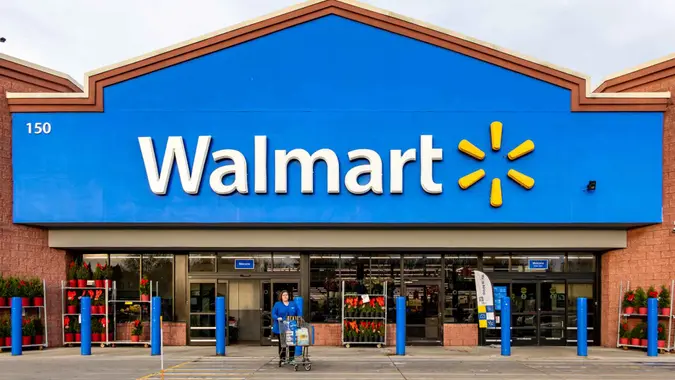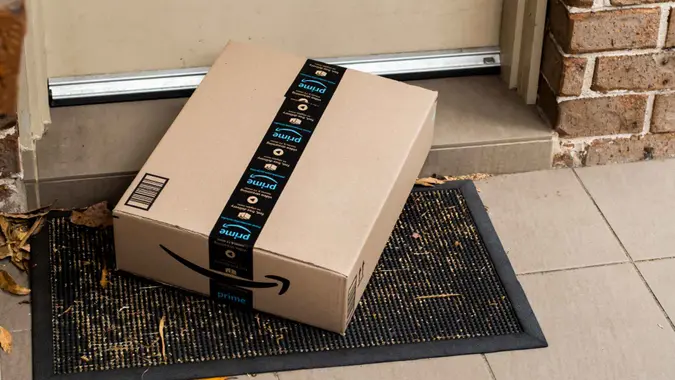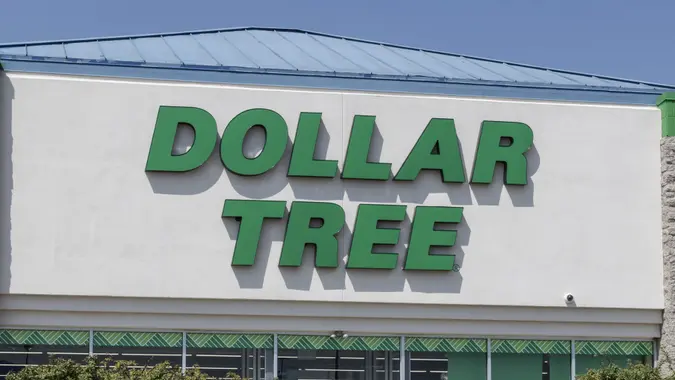Best Budgeting Apps For Saving Money in 2025

Commitment to Our Readers
GOBankingRates' editorial team is committed to bringing you unbiased reviews and information. We use data-driven methodologies to evaluate financial products and services - our reviews and ratings are not influenced by advertisers. You can read more about our editorial guidelines and our products and services review methodology.

20 Years
Helping You Live Richer

Reviewed
by Experts

Trusted by
Millions of Readers
Creating a budget can help you stay on track spending and savings goals. Using a budget app can help you keep to your budget. Here’s our pick for the best budget apps.
| App | Best for | Price |
|---|---|---|
| EveryDollar | Best streamlined zero-based budgeting app | – $17.99 per month – $79.99 per year after a 14-day free trial |
| YNAB | Best detailed zero-based budgeting app | – $14.99 per month – $109 per year |
| Monarch | Best for visualization | – $14.99 monthly – $99.99 annually |
| Empower | Best for wealth management | Free |
| Honeydue | Best for couples | Free |
| Goodbudget | Best for the envelope method | – $0 for Free Forever – $10 per month – $80 annually for Plus |
| Fudget | Best for simple budgeting | – Free for Fudget Basic – $19.99 annually for Fudget Plus Yearly – $14.99 every six months for Fudget Plus Bi-Yearly |
| PocketGuard | Best for overspenders | – $12.99 monthl – $74.99 yearly |
| Rocket Money | Best for choosing a subscription fee | – Free version – $6-$12 a month for premium features |
| Quicken Simplifi | Best for a comprehensive overview of your finances | $2.99 per month |
1. EveryDollar
Best streamlined zero-based budgeting app
Cost: $17.99 per month, $79.99 per year after a 14-day free trial
Key features: EveryDollar was created by personal finance expert Dave Ramsey. It uses a zero-based budgeting system, which means that every dollar has a job. Users can create a customized budget based on their income and expenses, track their spending and create savings goals.
Why we chose it:
- Intuitive platform with simple features that make navigation easy
- Enables users to create a customized budget and adjust it as needed
- Connects to over 10,000 banks and automatically imports transactions
- Offers spending insights based on your financial history
Cons:
- Your bank might not be supported, which will require you to manually input transactions
2. YNAB
Best detailed zero-based budgeting app
Cost: $14.99 per month, $109 per year
Key features: You Need A Budget, or YNAB, tracks your spending and lets you know how you can pay off your debt, start saving and more. It’s an excellent choice for zero-based budgeting. The website also has an impressive library of lessons that explain all kinds of budgeting topics.
Why we chose it:
- Easy-to-use interface
- Detailed graphs and color-coding give a quick glimpse of how much money you spent
- Includes access to a learning library, podcast and free live workshops
- Free 34-day trial that doesn’t charge you unless you subscribe at the end
Cons:
- Pricey compared to comparable budgeting apps
3. Monarch
Best for visualization
Cost: $14.99 monthly, $99.99 annually
Key features: If viewing your financial picture in the form of graphs and charts is important to you, Monarch’s easy-to-use platform may be what you’re looking for. You can sync your credit and bank accounts for automatic updating, set goals and view investments. Plus, you can create your own categories and view them in list form.
Why we chose it:
- Seven-day free trial
- Features for beginner and advances budgeters
- Monthly email report to help you see goal progress
- You can add other household members to the app
- Recurring transactions can be seen on the calendar for clarity
- Frequent upgrades and improvement of features
Cons:
- Seven-day free trial might not be long enough to decide if you should commit
- Pricier than some comparable options
4. Empower
Best for wealth management
Cost: Free
Key features: Empower, formerly Personal Capital, calculates your net worth, helps you budget and helps you plan for retirement — all for free. It features a robust, user-friendly dashboard that you can use to link all of your accounts, see custom household retirement projections, view spending trends by category and see month-to-month comparisons in spending.
Why we chose it:
- Offers tools for people who want to invest and plan for retirement
- Robust offering for planning and savings that doesn’t require you to pay a fee
- Investment Checkup tool to help you gauge the effectiveness of your portfolio
Cons:
- App may feel overwhelming for new budgeters
- Wealth management features might not be applicable for some people
5. Honeydue
Best for couples
Cost: Free
Key features: Honeydue is a free budgeting app designed to help couples manage their finances together. Couples can connect their bank accounts, credit card accounts and other financial accounts in one place, which allows them to see balances and transactions in real time.
Why we chose it:
- Allows couples to split expenses and track who owes what to whom
- Can be useful for couples who share expenses but have different incomes or spending habits
- Gives alerts for upcoming bills and when a budget category is exceeded
- Couples can chat within the app about money matters
- A joint bank account is available as an upgrade
Cons:
- The app has ads
- No investment portfolio or savings goals tool
6. Goodbudget
Best for the envelope method
Cost: $0 for Free Forever, $10 per month or $80 annually for Plus
Key features: By using the old envelope budgeting method, Goodbudget lets you track your envelope and account balances and sync them to multiple devices. You can make envelopes for all your budgeting categories and reserve money in each one based on that category.
Why we chose it:
- Sync and share your budget with others
- Goal setting and debt payoff available
- User-friendly mobile app
Cons:
- No direct syncing with financial institutions and requires manual entry
- Only one year of history is included with the free version
- Email support only available with the paid version
7. Fudget
Best for simple budgeting
Cost: Free for Fudget Basic, $19.99 annually for Fudget Plus Yearly, $14.99 every six months for Fudget Plus Bi-Yearly
Key features: If you’re looking for an ultra-simple app that helps you set a calculation-style spending plan without having to worry about syncing accounts, Fudget is a good option.
Why we chose it:
- Simple, list-style tallies of spending and income
- Star repeat expenses or income
- Create weekly or monthly budgets
Cons:
- You have to subscribe to the paid version to remove ads
- Minimal extra features in the upgraded paid version
8. PocketGuard
Best for overspenders
Cost: $12.99 monthly or $74.99 yearly
Key features: PocketGuard offers a simplified budgeting snapshot that will help you organize bills, expenses and subscriptions. You can sync your bank accounts and credit cards to the app, so you’ll know how much cash you have to spend at any time.
Why we chose it:
- Good for beginner and advanced budgeters
- Helps you set and keep savings and debt-payoff goals
- Good for those who like the 50/30/20 budget method
- Upload images of receipts and other items
Cons:
- Debt payoff plan and custom categories are only available in premium
9. Rocket Money
Best for choosing a subscription fee
Cost: Free version available; $6-$12 a month for premium features
Key features: Previously known as Truebill, Rocket Money helps you see your full financial picture while spending less and saving more. Upgrading to Premium for additional features, including concierge service to cancel recurring subscriptions, premium chat services, unlimited budgets, custom categories, real-time balance syncing and full credit report access.
Why we chose it:
- Free credit score
- Calculates how much you have to spend each month
- Identifies your top spending categories
- Spending goal tracker
- Spending alerts to help you stay on budget
10. Quicken Simplifi
Best for a comprehensive overview of your finances
Cost: $2.99 per month
Key features: The Simplifi app is brought to you by the money management platform Quicken. It provides you the ability to manage your finances while simultaneously monitoring your monthly budget.
Why we chose it:
- You can manage debt repayment and investing in one place
- Business owners can manager their personal and business expenses
- Can create a detailed monthly spending and savings plan
- User-friendly and easy to understand
Cons:
- Similar apps or platforms don’t have a subscription fee
Other Budgeting Options
A budgeting app isn’t the only way to keep track of your spending. You can create a budget and track your spending manually.
Free budgeting templates are also available online. Microsoft Excel has templates available that you can download to a computer. Alternatively, you can use a notebook or ledger sheet to create your own simplistic or detailed budget.
Choose the budgeting tool that works best for you. Be sure to include the following information:
- Amount of money you have coming in each month
- Your fixed expenses — rent, mortgage, internet bills, car payments and insurance
- Your variable expenses — food, gas and entertainment
Make a plan for your money. Perhaps you want to pay down debt or save for a big purchase. Look for places to cut back within your budget and divert that money toward your financial goals.
Review your budget regularly. Few people have the same expenses each month, and for many, it’s not unusual to earn varying amounts of income from month to month. You may have a surprise expense or even a surplus after a raise. Adjust your budget accordingly.
Caitlyn Moorhead, Barri Segal, Cynthia Measom and Cynthia Bowman contributed to the reporting for this article.
FAQ
- What is the best free budgeting app?
- Honeydue, Empower, Goodbudget Rocket Money and Fudget are all great apps with free membership options.
- Are budgeting apps safe to use with my bank account?
- All budgeting apps should take steps to secure your personal information. Make sure to read the privacy policy to understand how the company handles any information you share.
- Can budgeting apps help me save money faster?
- Some people find that budgeting apps help them stick to a budget and meet savings goals faster. You might have to try a few different apps before you find one that works best for you.
- What’s the difference between a budgeting app and a spreadsheet?
- Budgeting apps can have features that can make budgeting easier than keeping a spreadsheet. This can include syncing to your accounts and sending alerts when you go over budget.
- Do budgeting apps work for couples or families?
- Apps like Honeydue and Monarch can be great tools for helping a household maintain a budget together.
 Written by
Written by  Edited by
Edited by 

























